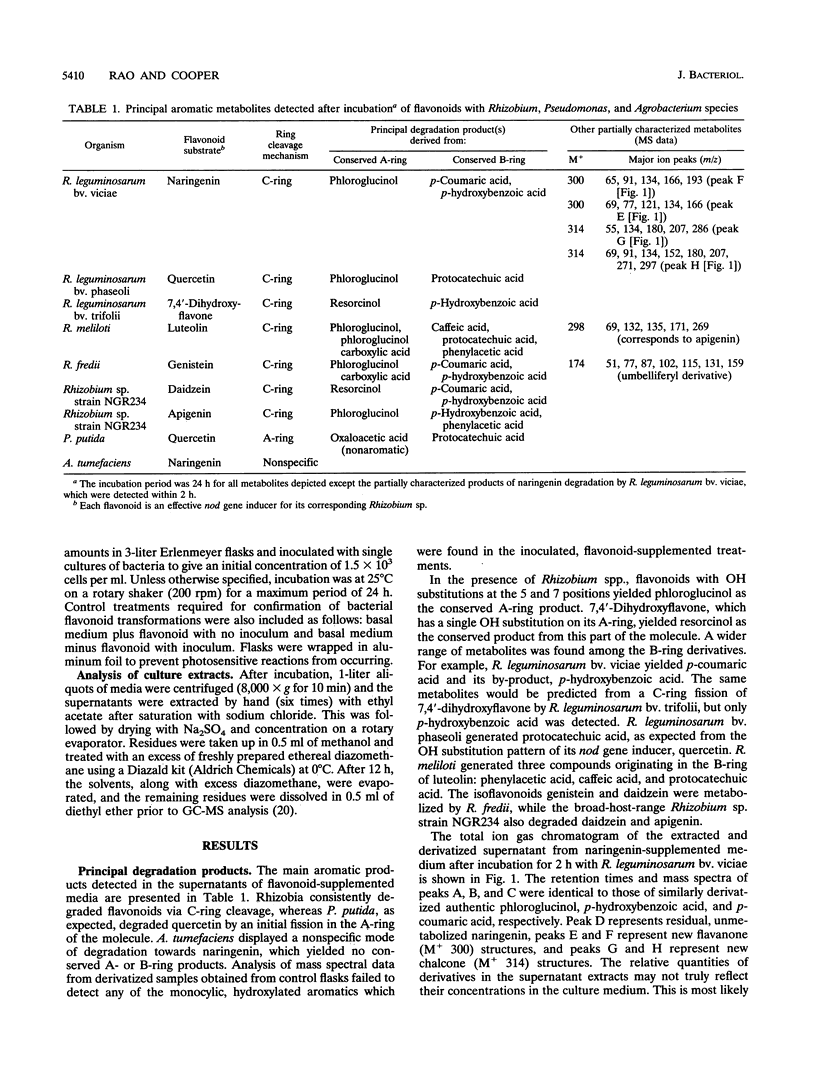Abstract
Gas chromatographic and mass spectrometric analyses of derivatized culture medium extracts were used to identify the products of flavonoid metabolism by rhizobia. A number of Rhizobium species and biovars degraded their nod gene-inducing flavonoids by mechanisms which originated in a cleavage of the C-ring of the molecule and which yielded conserved A- and B-ring products among the metabolites. In contrast, Pseudomonas putida degraded quercetin via an initial fission in its A-ring, and Agrobacterium tumefaciens displayed a nonspecific mode of flavonoid degradation which yielded no conserved A- or B-ring products. When incubated with rhizobia, flavonoids with OH substitutions at the 5 and 7 positions yielded phloroglucinol as the conserved A-ring product, and those with a single OH substitution at the 7 position yielded resorcinol. A wider range of structures was found among the B-ring derivatives, including p-coumaric, p-hydroxybenzoic, protocatechuic, phenylacetic, and caffeic acids. The isoflavonoids genistein and daidzein were also degraded via C-ring fission by Rhizobium fredii and Rhizobium sp. strain NGR234, respectively. Partially characterized aromatic metabolites with potential nod gene-inducing activity were detected among the products of naringenin degradation by Rhizobium leguminosarum bv. viciae. The initial structural modification of nod gene-inducing flavonoids by rhizobia can generate chalcones, whose open C-ring system may have implications for the binding of inducers to the nodD gene product.
Full text
PDF




Selected References
These references are in PubMed. This may not be the complete list of references from this article.
- Broughton W. J., Dilworth M. J. Control of leghaemoglobin synthesis in snake beans. Biochem J. 1971 Dec;125(4):1075–1080. doi: 10.1042/bj1251075. [DOI] [PMC free article] [PubMed] [Google Scholar]
- Dakora F. D., Joseph C. M., Phillips D. A. Alfalfa (Medicago sativa L.) Root Exudates Contain Isoflavonoids in the Presence of Rhizobium meliloti. Plant Physiol. 1993 Mar;101(3):819–824. doi: 10.1104/pp.101.3.819. [DOI] [PMC free article] [PubMed] [Google Scholar]
- Göttfert M. Regulation and function of rhizobial nodulation genes. FEMS Microbiol Rev. 1993 Jan;10(1-2):39–63. doi: 10.1111/j.1574-6968.1993.tb05863.x. [DOI] [PubMed] [Google Scholar]
- Hartwig U. A., Joseph C. M., Phillips D. A. Flavonoids Released Naturally from Alfalfa Seeds Enhance Growth Rate of Rhizobium meliloti. Plant Physiol. 1991 Mar;95(3):797–803. doi: 10.1104/pp.95.3.797. [DOI] [PMC free article] [PubMed] [Google Scholar]
- Hartwig U. A., Maxwell C. A., Joseph C. M., Phillips D. A. Effects of alfalfa nod gene-inducing flavonoids on nodABC transcription in Rhizobium meliloti strains containing different nodD genes. J Bacteriol. 1990 May;172(5):2769–2773. doi: 10.1128/jb.172.5.2769-2773.1990. [DOI] [PMC free article] [PubMed] [Google Scholar]
- Hirsch A. M., Bhuvaneswari T. V., Torrey J. G., Bisseling T. Early nodulin genes are induced in alfalfa root outgrowths elicited by auxin transport inhibitors. Proc Natl Acad Sci U S A. 1989 Feb;86(4):1244–1248. doi: 10.1073/pnas.86.4.1244. [DOI] [PMC free article] [PubMed] [Google Scholar]
- Jacobs M., Rubery P. H. Naturally occurring auxin transport regulators. Science. 1988 Jul 15;241(4863):346–349. doi: 10.1126/science.241.4863.346. [DOI] [PubMed] [Google Scholar]
- Maxwell C. A., Phillips D. A. Concurrent Synthesis and Release of nod-Gene-Inducing Flavonoids from Alfalfa Roots. Plant Physiol. 1990 Aug;93(4):1552–1558. doi: 10.1104/pp.93.4.1552. [DOI] [PMC free article] [PubMed] [Google Scholar]
- Peters N. K., Frost J. W., Long S. R. A plant flavone, luteolin, induces expression of Rhizobium meliloti nodulation genes. Science. 1986 Aug 29;233(4767):977–980. doi: 10.1126/science.3738520. [DOI] [PubMed] [Google Scholar]
- Peters N. K., Verma D. P. Phenolic compounds as regulators of gene expression in plant-microbe relations. Mol Plant Microbe Interact. 1990 Jan-Feb;3(1):4–8. doi: 10.1094/mpmi-3-004. [DOI] [PubMed] [Google Scholar]
- Rao J. R., Sharma N. D., Hamilton J. T., Boyd D. R., Cooper J. E. Biotransformation of the Pentahydroxy Flavone Quercetin by Rhizobium loti and Bradyrhizobium Strains (Lotus). Appl Environ Microbiol. 1991 May;57(5):1563–1565. doi: 10.1128/aem.57.5.1563-1565.1991. [DOI] [PMC free article] [PubMed] [Google Scholar]
- Recourt K., Schripsema J., Kijne J. W., van Brussel A. A., Lugtenberg B. J. Inoculation of Vicia sativa subsp. nigra roots with Rhizobium leguminosarum biovar viciae results in release of nod gene activating flavanones and chalcones. Plant Mol Biol. 1991 May;16(5):841–852. doi: 10.1007/BF00015076. [DOI] [PubMed] [Google Scholar]
- Recourt K., Verkerke M., Schripsema J., van Brussel A. A., Lugtenberg B. J., Kijne J. W. Major flavonoids in uninoculated and inoculated roots of Vicia sativa subsp. nigra are four conjugates of the nodulation gene-inhibitor kaempferol. Plant Mol Biol. 1992 Feb;18(3):505–513. doi: 10.1007/BF00040666. [DOI] [PubMed] [Google Scholar]
- Recourt K., van Brussel A. A., Driessen A. J., Lugtenberg B. J. Accumulation of a nod gene inducer, the flavonoid naringenin, in the cytoplasmic membrane of Rhizobium leguminosarum biovar viciae is caused by the pH-dependent hydrophobicity of naringenin. J Bacteriol. 1989 Aug;171(8):4370–4377. doi: 10.1128/jb.171.8.4370-4377.1989. [DOI] [PMC free article] [PubMed] [Google Scholar]
- Schlaman H. R., Spaink H. P., Okker R. J., Lugtenberg B. J. Subcellular localization of the nodD gene product in Rhizobium leguminosarum. J Bacteriol. 1989 Sep;171(9):4686–4693. doi: 10.1128/jb.171.9.4686-4693.1989. [DOI] [PMC free article] [PubMed] [Google Scholar]
- Winter J., Moore L. H., Dowell V. R., Jr, Bokkenheuser V. D. C-ring cleavage of flavonoids by human intestinal bacteria. Appl Environ Microbiol. 1989 May;55(5):1203–1208. doi: 10.1128/aem.55.5.1203-1208.1989. [DOI] [PMC free article] [PubMed] [Google Scholar]


